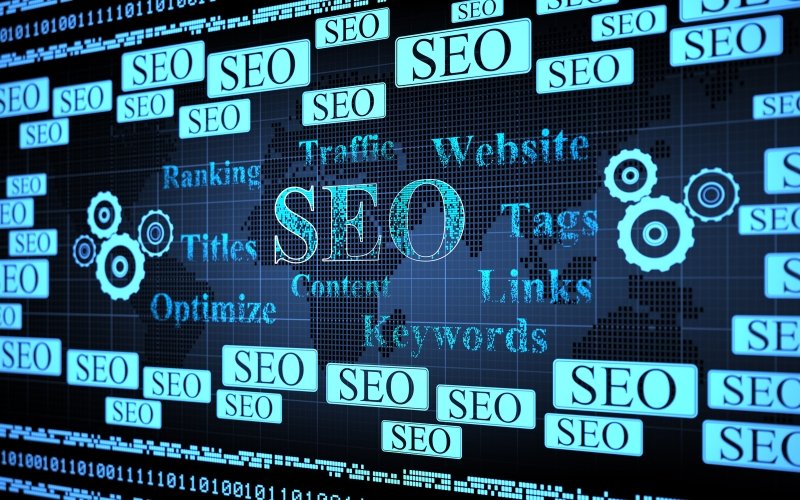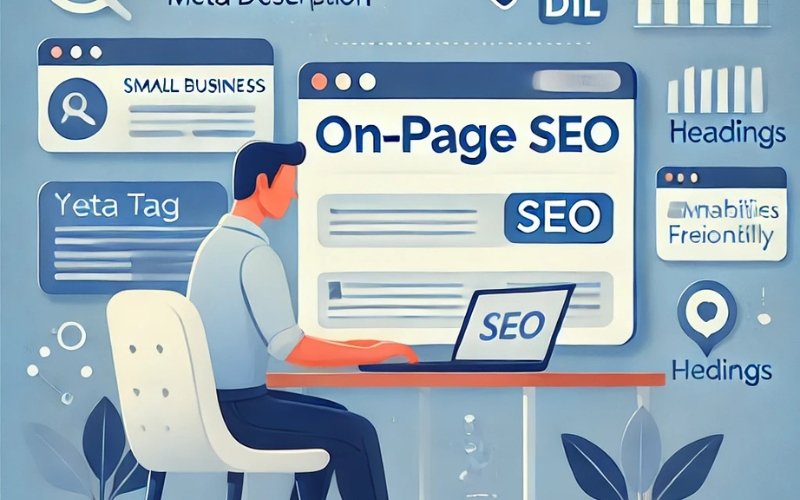For small businesses with limited budgets, paying for professional web developers to handle on-page SEO can be costly. However, many crucial on-page SEO optimizations don’t require a developer at all. You can take charge of these simple but powerful tactics to boost your site’s visibility, ranking, and overall user experience without needing advanced technical skills.
In this article, we’ll explore some essential on-page SEO elements that you can optimize yourself and improve your website’s SEO performance without breaking the bank.
1. Craft Keyword-Rich Title Tags

The title tag is a cornerstone of on-page SEO and plays a pivotal role in driving traffic and improving search engine rankings. It serves as the first impression your content makes on both users and search engines. A well-crafted title tag that incorporates targeted keywords can significantly enhance your ability to optimize on-page SEO while encouraging users to click through to your site.
When crafting a title tag:
- Include Your Primary Keyword Early: Placing your main keyword near the beginning of the title signals its importance to search engines, helping you optimize on-page SEO effectively.
- Stay Within the Character Limit: Keeping your title under 60 characters ensures that it displays fully in search results, maintaining its impact on users.
- Make It Engaging and Relevant: A compelling title not only attracts clicks but also aligns with user intent, further boosting your efforts to optimize on-page SEO.
For instance, rather than a generic title like “SEO Basics,” a more engaging option could be “How to Optimize On-Page SEO for Better Rankings.” This approach includes the target keyword naturally while clearly communicating the value of the content.
By following these strategies, your title tags will become a powerful tool to enhance visibility and optimize on-page SEO for your website.
2. Write Compelling Meta Descriptions
Meta descriptions may not directly impact your website’s rankings, but their influence on click-through rates (CTR) is undeniable. As the brief snippet displayed beneath your page title in search results, a meta description acts as a mini-advertisement for your content. Writing an engaging and clear meta description is an essential step to Optimize On-Page SEO, as it attracts more clicks and drives relevant traffic to your site.
To create a high-quality meta description that boosts CTR and Optimize On-Page SEO, consider the following tips:
- Keep It Concise: Ensure your meta description is under 155 characters to avoid truncation in search engine results. A concise description is more likely to deliver a clear and immediate value proposition to users.
- Include the Primary Keyword: Naturally integrate your primary keyword into the description to signal relevance to both users and search engines.
- Focus on User Intent: Address the specific needs and questions of your audience by highlighting what users will gain from visiting your page.
For example, a well-crafted meta description for an SEO services page could be:
“Discover practical strategies to Optimize On-Page SEO for your small business. Boost traffic, improve visibility, and achieve better rankings.”
Remember, your meta description should not only include your target keyword but also resonate with the user’s intent. When crafted effectively, it can become a powerful tool to Optimize On-Page SEO by improving CTR, increasing organic traffic, and enhancing overall engagement. Take the time to refine this crucial element, as it directly contributes to the success of your on-page optimization efforts.
3. Use Heading Tags Effectively
Headings (H1, H2, H3, etc.) are essential for improving both user experience and SEO. They organize content, making it easier to read and navigate, while also helping search engines understand the structure and relevance of your page. Using heading tags effectively is a straightforward yet powerful way to optimize on-page SEO.
Why Are Heading Tags Important?
Headings break up long-form content into smaller, digestible sections, enhancing readability and keeping users engaged. They also act as signposts for search engines, providing context about your content’s hierarchy and the importance of each section. Proper use of heading tags ensures that search engines can easily crawl and index your page, helping you optimize on-page SEO for better rankings.
Best Practices for Heading Tags
- H1: The Main Title
Your H1 tag should represent the primary topic of the page. It should be clear, concise, and include your target keyword. Since it holds the most weight in SEO, it plays a critical role in efforts to optimize on-page SEO. - H2 and H3: Subheadings
These tags are used to break down content into sections and subsections, creating a logical flow. Subheadings should include variations of your keywords to enhance relevance while maintaining natural language. This reinforces the page’s focus, helping search engines and readers alike. - Keyword Placement in Headings
Naturally incorporate keywords in headings without overstuffing. For example, a blog about “SEO Strategies” might use:
- H1: Proven SEO Strategies for 2024
- H2: How to Optimize Title Tags for Search Engines
- H3: Why Keywords Are Vital to On-Page SEO
How Headings Boost On-Page SEO
Effective headings not only improve readability but also signal the content’s hierarchy and relevance. Search engines prioritize content organized with proper headings, making them a key element in efforts to optimize on-page SEO. A well-structured page can improve user engagement metrics, such as time on site, which also benefits your rankings.
In conclusion, headings are more than just formatting tools—they’re a crucial component of your SEO strategy. By using them thoughtfully and incorporating relevant keywords, you create content that is both user-friendly and optimized for search engines. This dual approach is an essential step to successfully optimize on-page SEO.
4. Optimize URLs for Search Engines and Users

Your page URL is another important element to Optimize On-Page SEO. A clean, concise, and descriptive URL makes it easier for both users and search engines to understand the content of your page.
To Optimize On-Page SEO through URLs:
- Use your primary keyword in the URL for better visibility.
- Keep it short and simple, ideally under 60 characters.
- Avoid using unnecessary words like “and” or “the” in URLs.
For example, instead of “www.yoursite.com/page123,” use “www.yoursite.com/on-page-seo-tips” for a clear and SEO-friendly URL that helps Optimize On-Page SEO effectively. Consistently following these practices ensures your URLs contribute to the broader effort to Optimize On-Page SEO.
5. Add Alt Text to Your Images
Images are a vital part of any website, but search engines can’t “see” images in the same way users do. That’s where alt text (alternative text) comes in. Alt text describes what the image represents, which helps search engines understand your content better and improves accessibility for visually impaired users.
To optimize image alt text:
- Describe the image accurately in a few words.
- Include your keyword, if relevant, but don’t overstuff keywords.
- Ensure every image on your page has alt text.
For example, if you’re using an image of a laptop displaying SEO analytics, your alt text might be: “Laptop displaying SEO analytics report for small business.”
6. Ensure Mobile Responsiveness
With more than half of all web traffic coming from mobile devices, having a mobile-friendly website is no longer optional—it’s essential for SEO. Google uses mobile-first indexing, meaning it predominantly uses the mobile version of your site for ranking and indexing.
To optimize for mobile:
- Use responsive design, so your site adjusts seamlessly to different screen sizes.
- Compress images to reduce page load time on mobile.
- Test your site’s mobile performance using Google’s Mobile-Friendly Test tool to ensure it works well on all devices.
If your site isn’t mobile-responsive, you may lose out on a significant portion of traffic, which could negatively affect your rankings.
7. Improve Page Speed for Better User Experience
Page speed is a crucial ranking factor, especially for mobile. A slow-loading website can frustrate users and cause them to leave, increasing your bounce rate and hurting your SEO performance.
To improve page speed:
- Compress images and use proper file formats (like JPEG for photos and PNG for graphics).
- Enable browser caching to help pages load faster on repeat visits.
- Minimize JavaScript and CSS files to reduce load time.
You can use free tools like Google PageSpeed Insights to evaluate your website’s performance and get recommendations for improvement.
8. Use Internal Linking Strategically

Internal links are an easy way to improve your site’s SEO without needing any technical skills. By linking to other relevant pages on your website, you can help search engines understand the structure of your site and keep users on your site longer.
To optimize internal links:
- Link relevant content within your site, such as blog posts, product pages, or service pages.
- Use descriptive anchor text that includes keywords and gives context to the linked page.
- Avoid overloading a single page with too many internal links; spread them naturally throughout your content.
For instance, if you’re writing about on-page SEO and have another article about off-page SEO, you can include an internal link with the anchor text “learn more about off-page SEO.”
Conclusion
Optimizing on-page SEO without a developer is entirely possible with the right strategies. By focusing on elements such as title tags, meta descriptions, alt text, and page speed, you can improve your website’s search engine visibility and user experience without needing extensive technical knowledge.
The key is consistency and paying attention to the small details that can make a big difference in how search engines and users perceive your site. With these simple yet effective on-page SEO techniques, you can boost your small business’s website ranking and attract more traffic without the need for costly web development services.

